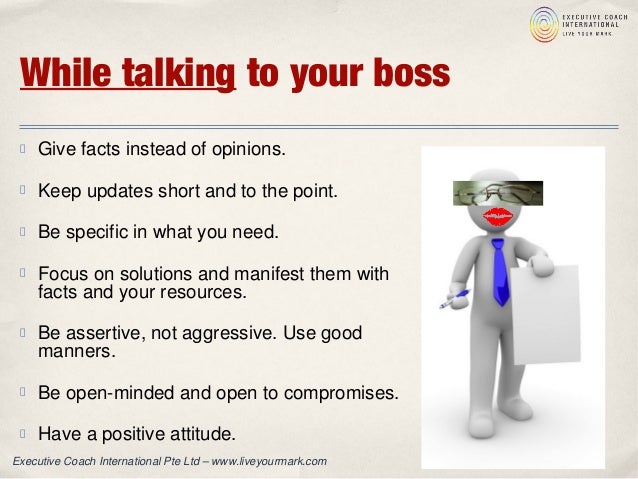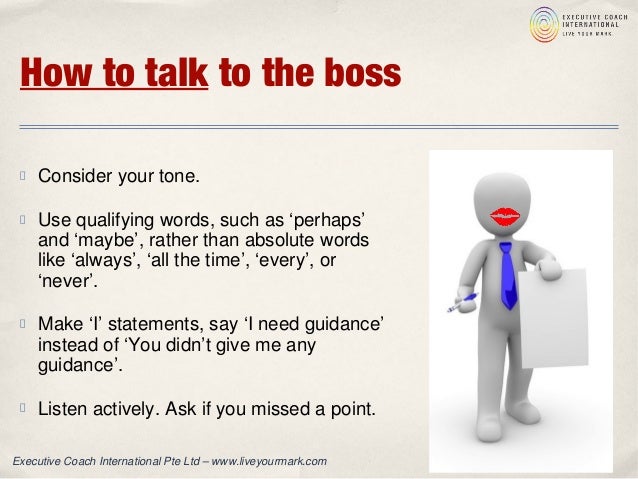How To Speak To Your Boss About A Problem

The fluorescent lights hummed a monotonous tune above Sarah’s head as she stared at her computer screen. A knot of anxiety tightened in her stomach. A persistent problem with the new software rollout was eating into her team's productivity, and she knew she needed to speak to her boss, Mark. But the thought of confronting him, known for his sometimes gruff demeanor, filled her with apprehension. The question loomed: How do you effectively communicate a problem to your boss without sounding like a complainer, but rather a solution-oriented team member?
The ability to address workplace issues with your superiors is crucial for both individual success and the overall health of the organization. Navigating these conversations requires a blend of tact, preparation, and a focus on collaborative problem-solving. Learning how to approach these conversations strategically can turn potential conflicts into opportunities for growth and improved efficiency.
Understanding the Importance of Communication
Open communication between employees and management is the backbone of a thriving workplace. According to a 2023 study by Gallup, employees who feel their voice is heard are nearly five times more likely to feel empowered to perform their best work. Failing to address issues can lead to decreased morale, reduced productivity, and potentially even increased turnover.
Ignoring problems in the hope they will disappear is rarely a viable strategy. Instead, proactively addressing concerns with your boss allows for collaborative solutions and demonstrates your commitment to the company's success.
Preparing for the Conversation
Before scheduling a meeting, take time to thoroughly prepare. Clearly define the problem, gather relevant data, and brainstorm potential solutions. The more information you have, the more productive the conversation will be.
Consider the impact of the problem on the team or the company as a whole. Quantify the issue whenever possible. For example, instead of saying "the new software is slow," try "the new software is causing a 20% decrease in task completion rates."
Documenting the Issue
Detailed documentation can be invaluable. Keep a log of specific instances where the problem occurred, including dates, times, and any relevant details. This provides concrete evidence and helps to avoid vague or unsubstantiated claims.
Having this information readily available will demonstrate that you've taken the issue seriously and are prepared to discuss it in a meaningful way.
Brainstorming Solutions
Going to your boss with only a problem can sometimes be perceived as complaining. Take the initiative to brainstorm potential solutions, even if you aren't sure they are feasible. Presenting these solutions demonstrates a proactive and problem-solving mindset.
Even if your suggested solutions aren't ultimately implemented, the act of offering them shows your willingness to contribute to a positive outcome. It sets the tone for a collaborative discussion, where you and your boss can explore different options together.
During the Conversation
When you meet with your boss, start by clearly stating the problem and its impact. Be respectful and professional, even if you are feeling frustrated. Focus on the facts, and avoid emotional language or personal attacks.
Actively listen to your boss's perspective. They may have insights or information that you are not aware of. Be open to feedback and willing to compromise. Remember that the goal is to find a mutually agreeable solution.
Choosing the Right Time and Place
Consider the timing and setting of your conversation. Avoid bringing up sensitive issues during busy times or in public areas. Schedule a dedicated meeting time where you can have a private and uninterrupted discussion.
Respecting your boss's time and creating a conducive environment shows that you value their input and are committed to a productive conversation.
Focusing on Solutions, Not Blame
Frame the issue as a shared challenge rather than placing blame. Emphasize that you are seeking their help in finding a solution that benefits the entire team or organization. This collaborative approach can foster a more positive and productive dialogue.
Avoid using accusatory language or focusing on past mistakes. Instead, concentrate on the present situation and how to improve it moving forward.
Following Up After the Conversation
After the meeting, follow up with a brief email summarizing the key points discussed and any agreed-upon action steps. This helps ensure that everyone is on the same page and provides a written record of the conversation.
If specific actions were assigned to you, be sure to complete them in a timely manner. Keep your boss informed of your progress and any challenges you encounter. This demonstrates your commitment to resolving the issue and your accountability as a team member.
Speaking to your boss about a problem doesn't have to be a daunting task. By preparing thoroughly, communicating effectively, and focusing on solutions, you can turn potential conflicts into opportunities for growth and collaboration. Remember Sarah, who was apprehensive about speaking to Mark? With careful preparation and a positive attitude, she successfully communicated the software problem. This led to a solution that not only improved her team's productivity but also strengthened her relationship with her boss.
Ultimately, learning to navigate these conversations constructively empowers you to become a more valuable and effective member of your organization. It's about transforming perceived problems into opportunities for positive change and shared success. Open communication is not just a buzzword; it’s the key to a healthier, more productive, and more fulfilling work environment.


















